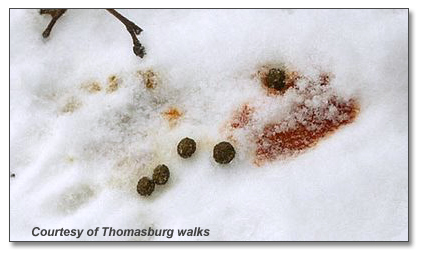Urine Discoloration - Red, Orange, Brown, White Urine
rabbits, chinchillas, guinea pigs
Usually chinchilla, rabbit, guinea pig urine is pale yellow or yellow. However, the color can vary from yellow to orange or even red/brown. Urine may also be cloudy. Various substances can contribute to turbidity, including crystals (calcium carbonate, oxalate, triple phosphate) and lipids. Most common cause of cloudy urine is calciuria, see white urine for more info.
"Red urine" is often mistaken for blood. When you notice reddish urine for the first time, it's logical to assume that there is blood in the urine. Often blood in the urine is not visible to the naked eye and if you do not see any other symptoms, including loss of appetite, straining, frequent urination, weakness, it can be just the excretion of plant pigments or other reasons listed below.

Porphyrinuria (orange/reddish colored by-products from plant components, including chlorophyll, a magnesium porphyrin in the urine) in herbivores. Yellow urine darkens to a red-brown after exposure to light.
Normal color should return within a few days. If not, urine can be evaluated. Dipstick test will differentiate between true blood and just "red urine."
Causes of "red urine":
- Excretion of plant pigments. For example, orange/red urine is produced when porphyrins (pigments that are abundant in nature) are excreted in the urine. Consumption of certain vegetables and plants like beet root, some bark, blackberries or those high in beta-carotene, such as carrots and spinach, can exhibit more red pigment in the urine. Some chinchillas, rabbits, guinea pigs and other herbivores may not be effected by this, and it probably depends on what else is consumed. It's like with people, beeturia occurs in only about 12% - 14% of the population. If it happens to you, you'll notice that it does not happen all the time, as it also depends on what else you ate and when you ate (acidity of the stomach).
- Normal urine may appear darker if chinchilla, rabbit, guinea pig, degu or other herbivores is dehydrated. The intensity of the color depends on the level of dehydration. Some animals will refuse to drink if you add vitamins to the water (we do not recommend this) or if water is stale.
- Excessive amount of iron or B vitamins passed in the urine can cause an orange, reddish - brown discoloration of the urine. It's usually a problem with herbivores that consume mostly pellets as they contain high levels of synthetic vitamins and minerals. Herbivores' urine is usually yeallow if they are on a natural diet.
- Some antibiotics may increase the levels of pigments in the urine.
- Liver and blood diseases can result in increased levels of bilirubin and urobilinogen that change urine color.
Causes of true blood in the urine:
- Physical trauma. For example, chinchilla, rabbit, guinea pig, degu or other herbivore fell from a high place.
- Source of blood can be urinary (infection, stones) or reproductive system. Blood from the reproductive system is usually associated with blood passed at the end of urination or with blood clots. When the cause of blood is urinary disorders, you can notice straining or pain during urination; blood is usually mixed evenly with the urine. Animals that have blood in the urine may also be anemic.
When urine dries, you may see white, chalky residue (should not be thick, pasty). Generally, some white urine residue is not a problem; it usually means that excess calcium is being excreted. If you notice that urine is white, then calcium intake should be significantly reduced. Reduce the amount of pellets and legume hays and offer lots of grass hays (timothy, orchard grass, brome, meadow, bluegrass, etc.). High protein diets may increase calcium excretion in older herbivores.




